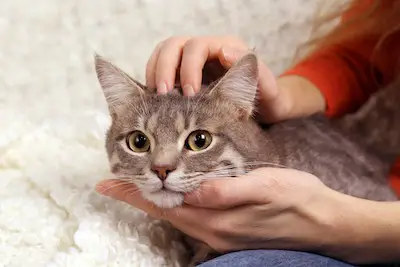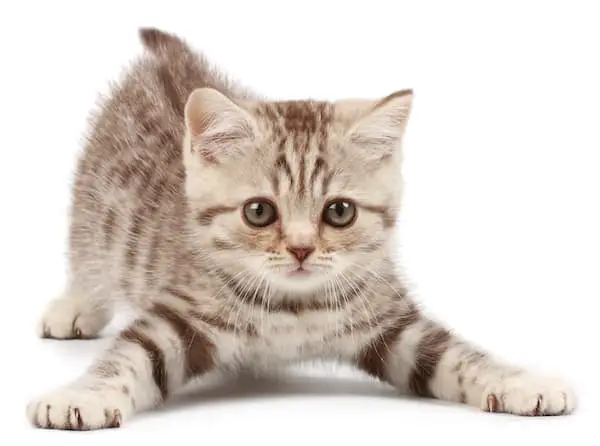Updated on
The first thing I want to say about cat pregnancy is that it should be avoided whenever possible. We all know the statistics about unwanted animals filling the shelters-so if you have a cat, get it spayed or neutered. However, as we all know, things happen.
Maybe Snowball slipped outside the week before her vet appointment, and now you have more Snowballs on the way. Could be that you adopted a stray who was already in the family way, and you hope to give the kittens a good start in life. Or, as in my case, you have volunteered to do foster care for your local shelter, and you have a momma-to-be purring on your lap as you read this.
Whatever the case, when it comes to the birth of kittens, it is a good idea to know what you are getting into before the big day (or night) arrives.
Contents
Gestation


You'll find many sources that say normal gestation for cats is 65 days. I've found that this information is not really very useful, as one must know the date on which the cat mated in order to count the days.
Because my experience with cat pregnancy has been with foster cats that arrive at my house already pregnant (and who had arrived at the shelter that way), all I have ever been able to do is guess, based on the size of the cat's "baby bump."
And my guesses tend to be incorrect. I had one cat that went three weeks beyond the due date I had guessed for her, and one who surprised me by delivering when I thought she had another month to go. So unless you know exactly when your cat got pregnant, good luck trying figuring out when the kittens will come.
However, if you know for sure that your cat has been pregnant for more than 65 days, you may want to contact your vet, as prolonged pregnancies can pose health hazards for both momma and kittens.
Cat Behavior Before Birth
You'll know the time is near, however, when your cat starts to exhibit particular birthing behaviors. In the week leading up to the birth, you will probably notice that your momma cat can't seem to get comfortable. Any human mom will be able to identify with this.
Your cat may also start to look for a secluded spot to deliver her litter. This may be a good time to shut the cat into the area where you want her to give birth so that the mess is contained (more on this later). One behavior I have noticed in several of my momma cats is that they will attempt to lick their humans once labor starts. If your cat starts to compulsively lick your face or hands-and won't stop even if you shoo her away-she may be starting labor.
Finally, you'll know for sure the moment has arrived when the cat begins to pant with an open mouth, and when you can visually see the contractions squeezing her middle. You can be pretty certain at this point that you will have kittens within an hour.
It Gets Messy
I hate to say this, but it's going to get messy.


Just a heads up if you have never seen a litter of kittens born: it's messy. I've found that cats rarely stay in one place while they are giving birth-they like to walk around and move from one spot to another-so if you want to save your good linens, move your cat to an appropriate birthing spot before her labor even starts.
Otherwise, you could be surprised to come home after work and find your bedspread has been used as a delivery table, or that your beige carpet is no longer beige.It's important that someone monitor the birth in case things start to go wrong.
However, if you are squeamish, you may want to find someone to stand in for you. The kittens are born still encased in their amniotic sac, which the mother will remove with her teeth. One of the grossest aspects of the birthing process (in my opinion) is that cats eat the placentas-so be prepared for that as well.
You also may be surprised by just how small freshly minted kittens are. I might compare them to the size of an adult mouse. They really won't start to look like those cute calendar kittens for at least two or three weeks. Right after birth they will be wet and squirmy with their umbilical cords still attached, and of course, their eyes will be sealed shut. It takes a real cat lover to see something cute in all this-fortunately I am a cat lover, so I think newborns are adorable.
When to Intervene or Get the Vet Involved


Most of the time, momma will be able to deliver her litter with no problem at all. It's a good idea to keep an eye on her through the process, however, in case she needs human intervention. A common issue to come is that a kitten will get stuck halfway out of the birth canal. It's okay to take hold of the kitten and gently pull. I did this with one of my foster cats when one kitten was born breech, and everything "came out okay."
If the momma gives birth to a kitten but doesn't seem to notice it (oddly, this can happen), draw her attention to the baby so that she can begin to lick it. Newborn kittens need to be stimulated in order to start breathing, so this needs to happen within seconds of birth. If the momma does not seem interested in doing this job, you may want to take a paper towel to remove any membranes from the kitten's face. Then gently rub the newborn to get it to start to breath.
Like any birthing process, there is pain involved, and you may hear some yowling. But if your cat seems to be in distress for a prolonged period of time without giving birth, call the vet. Another sign of trouble is if the cat is lethargic or if the labor lasts for over a day with no progress. This is definitely time to get the vet involved.
Helping Momma Get Used to the Babies
Most cats are natural mothers, but there can be exceptions. If this is the first litter for your cat, particularly if she is a very young mom, she may seem as if she does not know what to do with her babies.
If she ignores them, try putting the mom and the babies in a small-enclosed area like a closet or a small bathroom. Because there will be nothing else for mom to do, she may take an interest in her kittens and start to nurse them.
One of my foster cats seemed very nervous and would not lie down with her litter. I found that if a human were petting her, she would lie still, giving her babies a chance to nurse. Fortunately, if you have to do something like this, it probably won't be for long. Once the mom figures things out (usually by day two) things will be smooth sailing.
Just remember, it is important to do everything you can to get the mom to take charge; bottle-feed the kittens only as a last resort. Their mother's milk is much better for them-and bottle-feeding a litter of kittens is a tremendous amount of work.
Try to keep the babies in a nice warm area. It's okay to use a heating pad set on low to keep them warm. Be forewarned, momma cat may try to move her babies and hide them somewhere else in the house. If you want to keep them in one place, reserve a room of your house as the cat nursery and shut the kitties in. Just make sure that you provide as much food and water as the mom wants, and, of course, a litter box.
Don't be afraid to handle the babies from the moment of birth, as long as the mother is comfortable with it. Kittens that are handled often and early make wonderful pets. Around the age of 6 to 8 weeks, the kittens will be ready for adoption.
You on the other hand, may be so attached to them that you won't want to give them up. I know it's happened to me a time or two, which is why I now have four cats!